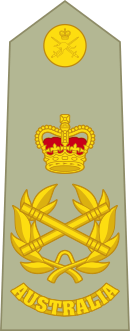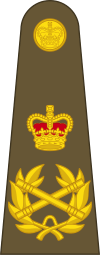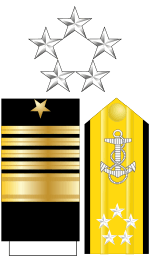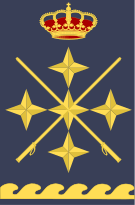Five-star rank
A five-star rank is a very senior military rank, first established in the United States in 1944, with a five-star general insignia,[1] and corresponding ranks in other countries. The rank is that of the most senior operational military commanders, and within NATO's "standard rank scale" it is designated by the code OF-10.

Not all armed forces have such a rank, and in those that do the actual insignia of the "five-star ranks" may not contain five stars. For example: the insignia for the French OF-10 rank maréchal de France contains 7 stars; the insignia for the Portuguese marechal contains four gold stars; and many of the insignia of the ranks in the Commonwealth of Nations contain no stars at all.
Typically, five-star officers hold the rank of general of the army, admiral of the fleet, field marshal, marshal or general of the air force, and several other similarly named ranks. Five-star ranks are extremely senior—usually the highest ranks. As an active rank, the position exists only in a minority of countries and is usually held by only a very few officers during wartime. In times of peace, it is usually held only as an honorary rank. Traditionally, five-star ranks are granted to distinguished military commanders for notable wartime victories and/or in recognition of a record of achievement during the officer's career, whether in peace or in war. Alternatively, a five-star rank (or even higher ranks) may be assumed by heads of state in their capacities as commanders-in-chief of their nation's armed forces.
Despite the rarity and seniority of five-star officers, even more-senior ranks have been adopted in the United States, namely, admiral of the navy and general of the armies. Other names for highly senior ranks from the twentieth century include généralissime (France), generalissimo (Spain) and generalissimus (USSR).
Australia
- Admiral of the fleet[nb 1]
- Field marshal[nb 1]
- Marshal of the Royal Australian Air Force[nb 1]
Only one Australian-born officer, Field Marshal Sir Thomas Blamey, has held a substantive Australian five-star rank. Lord Birdwood, who commanded the Australian Imperial Force in the First World War, was appointed to honorary five-star rank in the Australian Military Forces on his promotion to field marshal in the British Army in 1925.[2][3] King George VI and Prince Philip, Duke of Edinburgh have held all three Australian five-star ranks in an honorary capacity, and have been the only holders of the Australian ranks of admiral of the fleet and marshal of the RAAF.
 Australian Army Field Marshal
Australian Army Field Marshal
shoulder board RAN Admiral of the Fleet
RAN Admiral of the Fleet
shoulder board Marshal of the RAAF
Marshal of the RAAF
sleeve/shoulder insignia
Brazil
Five-star ranks in Brazil are only used in wartime.
- Marshal (Brazil) (Marechal)
- Grand Admiral (Almirante)
- Marshal of the Air (Marechal-do-Ar)
 Almirante
Almirante Marechal
Marechal Marechal-do-Ar
Marechal-do-Ar
Cambodia
- General of the Army (Khmer: នាយឧត្តមសេនីយ៍អគ្គមេបញ្ចាការ), Royal Cambodian Armed Forces
 General of the Army
General of the Army
Croatia
- Stožerni general (lit. "staff general", usually translated as general of the army) awarded to six men, none of whom are in active duty.
- Admiral flote (admiral of the fleet). The rank was called stožerni admiral (lit. "staff admiral") until 1999; only Sveto Letica was awarded this rank – in March 1996, three months before his retirement.
 Croatian Armed Forces
Croatian Armed Forces
(stožerni general) insignia Croatian Navy
Croatian Navy
(admiral flote) insignia
India
.gif)
.svg.png)
- Field Marshal, held by K. M. Cariappa and Sam Manekshaw
- Marshal of the Indian Air Force, held by Arjan Singh
- Admiral of the fleet, never been held
 Field marshal epaulette
Field marshal epaulette.jpg) Star insignia of a Field Marshal
Star insignia of a Field Marshal Marshal of the Indian Air Force shoulder insignia
Marshal of the Indian Air Force shoulder insignia Marshal of the Indian Air Force sleeve insignia
Marshal of the Indian Air Force sleeve insignia Marshal of the Indian Air Force rank insignia
Marshal of the Indian Air Force rank insignia Admiral of the fleet
Admiral of the fleet
Indian Navy (Shoulder Board)_OF-10.svg.png) Admiral of the fleet
Admiral of the fleet
Indian Navy (Sleeve Insignia)
Around 1998, the Indian Air Force introduced gorget patches (or collar tabs) for its air officers. For marshals of the Indian Air Force, the patches display five stars.[4]
Indonesia
Refer to government regulation No. 32/1997,[5] The Indonesian five star ranks are:
- Jenderal besar (grand general) - only awarded to three people:
- Jenderal besar Soedirman, the rank was granted posthumously.
- Jenderal besar Abdul Haris Nasution, the rank was granted 26-years after his retirement.
- Jenderal besar Soeharto (2nd President of Indonesia), his rank was granted during his own rule.
- Laksamana besar (grand admiral) - never awarded
- Marsekal besar (grand marshal) - never awarded
The five-star ranks above are honorary rank and does not provide additional authority or responsibility.
However, as government regulation No. 32/1997 have been revoked and replaced by government regulation No. 39/2010,[6] whereas the latest regulation don't mentioned five-star rank. Therefore, it is unlikely there will be any Indonesian military personnel to be awarded five-star rank.
 Jenderal besar rank insignia
Jenderal besar rank insignia Laksamana besar rank insignia
Laksamana besar rank insignia Marsekal besar rank insignia
Marsekal besar rank insignia
Italy
.svg.png) General of the Italian Army - shoulder board
General of the Italian Army - shoulder board Admiral of the Italian Navy - sleeve
Admiral of the Italian Navy - sleeve General of the Italian Air Force - sleeve
General of the Italian Air Force - sleeve
This ranks is used by the Italian Chief of General Staff only.
Pakistan
- Field marshal, held by Ayub Khan
- Marshal of the Air Force, never been held
- Admiral of the fleet, never been held
Poland
Marshal of Poland (Marszałek Polski) is a Polish Army five-star rank. There are today no living marshals of Poland, since this rank is bestowed only on military commanders who have achieved victory in war. The last appointment was in 1963 to Marian Spychalski.
 Marshal of Poland cap insignia
Marshal of Poland cap insignia Marshal of Poland shoulder-strap insignia
Marshal of Poland shoulder-strap insignia
Spain
- Captain general (Army)
- Captain general of the Navy
- Air captain general (Air Force)
Since 1922 it's not properly a rank but a "military dignity". The only full Capitán General is currently His Majesty the King of Spain, the last not-royal appointment (honorary) was in 1994 to Manuel Gutiérrez Mellado. The rank of Capitana General is currently bestowed also to several images of the Virgin Mary, among them la Virgen de Butarque, la Virgen del Pilar, la Virgen de Guadalupe, Nuestra Señora de los Reyes, la Virgen de los Desamparados (this one properly Capitana Generalísima), la Virgen de la Serra, la Virgen del Canto y la Virgen de los Remedios. The latest appointment was to Nuestra Señora de los Dolores, April 2011.
Thailand
- Chom Phon (Thai: จอมพล), Royal Thai Army
- Chom Phon Ruea (Thai: จอมพลเรือ), Royal Thai Navy
- Chom Phon Akat (Thai: จอมพลอากาศ), Royal Thai Air Force
.svg.png) Chom Phon (Field Marshal)
Chom Phon (Field Marshal).svg.png) Chom Phon Ruea (Admiral of the Fleet)
Chom Phon Ruea (Admiral of the Fleet).svg.png) Chom Phon Akat (Marshal of the Royal Thai Air Force)
Chom Phon Akat (Marshal of the Royal Thai Air Force)
The monarch of Thailand is appointed to the three ranks automatically upon accession as he is the constitutional Head of the Royal Thai Armed Forces. Since 1973 the three ranks have been reserved for members of the royal family.
United Kingdom
The worn insignia of British five-star commanders do not contain stars; the vehicle star plate, mounted on the front of a staff car, does display five stars.[7]
- Admiral of the fleet (awarded to 121 men to date)
- Field marshal (awarded to 140 men to date)
- Marshal of the Royal Air Force (awarded to 27 men to date)
- Captain General of the Royal Marines (awarded to five members of the British Royal Family, currently vacant.)
 Royal Navy admiral of the fleet (shoulder board)
Royal Navy admiral of the fleet (shoulder board)_OF-10.svg.png) Royal Navy admiral of the fleet (sleeve lace)
Royal Navy admiral of the fleet (sleeve lace) Field marshal of the British Army epaulette
Field marshal of the British Army epaulette Captain general of the Royal Marines epaulette
Captain general of the Royal Marines epaulette.svg.png) Marshal of the Royal Air Force (shoulder board)
Marshal of the Royal Air Force (shoulder board) Marshal of the Royal Air Force (sleeve insignia)
Marshal of the Royal Air Force (sleeve insignia)
Promotion to the ranks of admiral of the fleet and marshal of the Royal Air Force is now generally held in abeyance in peacetime with exceptions for special circumstances. Promotion to the rank of field marshal was generally stopped in 1995 as a cost-cutting measure but is still made in some cases.[8][9] The most recent appointments to five-star ranks are the promotions in 2012 of the Prince of Wales to honorary five-star rank in all three services, and of former Chief of the Defence Staff Lord Guthrie of Craigiebank to the honorary rank of field marshal.[9][10] In 2014 the former Chief of the Defence Staff Lord Stirrup was promoted to the honorary rank of marshal of the Royal Air Force.[11]
During World War II and after, serving NATO, a small number of British five-star commanders have held the additional title Supreme Allied Commander, given operational control over all air, land, and sea units led by the four-star commanders of multi-national forces.
United States
- Fleet Admiral (held by four officers)
- General of the Army (held by five officers)
- General of the Air Force (held by one officer)
Before the five-star ranks were established in 1944, two officers had previously been promoted from their four-star ranks to the superior and unique ranks of Admiral of the Navy and General of the Armies: Admiral George Dewey (appointment 1903 retroactive to 1899, died 1917) and General John J. Pershing (appointed 1919, died 1948). In 1944 the Navy and Army specified that these officers were considered senior to any officers promoted to the five-star ranks within their services (but it was not clear if they were senior by rank or by seniority due to an earlier date of rank).
Five-star ranks were created in the U.S. military during World War II because of the awkward situation created when some American senior commanders were placed in positions commanding allied officers of higher rank.[12] U.S. officers holding five-star rank never retire; they draw full active duty pay for life.[13] The five-star ranks were retired in 1981 on the death of General of the Army Omar Bradley.[12]
Nine Americans have been promoted to five-star rank, one of them, Henry H. Arnold, in two services (U.S. Army then later in the U.S. Air Force). As part of the bicentennial celebration, George Washington was, 177 years after his death, permanently made senior to all other U.S. generals and admirals with the title General of the Armies effective on 4 July 1976. The appointment stated he was to have "rank and precedence over all other grades of the Army, past or present".[nb 2]
During World War II and (later) serving NATO, a small number of American five-star commanders have also held the additional title of Supreme Allied Commander, given operational control over all air, land, and sea units led by the four-star commanders of multi-national forces.
 Fleet admiral collar device, sleeve stripes and shoulder board
Fleet admiral collar device, sleeve stripes and shoulder board General of the Army shoulder strap
General of the Army shoulder strap General of the Air Force shoulder epaulet
General of the Air Force shoulder epaulet
See also
- Ranks and insignia of NATO
- List of fleet and grand admirals
- List of field marshals
- List of marshals of the Air Force
- Design of US army insignia
- Heraldic origin of the use of five-pointed star
- Six-star rank
- Four-star rank
Notes
- The Australian insignia for admiral of the fleet, field marshal and marshal of the Royal Australian Air Force, depending on the era, are either identical to, or very similar to, the British insignia. Currently, Prince Philip is the only holder of these Australian ranks. Note that although the highest active New Zealand rank is three-star, (there are no New Zealand four-star rank holders), Prince Philip holds five-star ranks in the New Zealand Armed Forces.
-
The following Americans have been promoted to five-star rank:
The timing of the first seven appointments was to establish both a clear order of seniority and a near-equivalence between the Army and Navy services. In 1949, Arnold was honored by being made the first, and to date only, general of the air force. He is the only American to serve in a five-star rank in two of its military services. By a Congressional Act of 24 March 1903, Admiral George Dewey's rank was established as admiral of the navy, a rank which was specified to be senior to the four-star rank of admiral and was equal to admiral of the fleet in the British Royal Navy. Admiral Dewey was the only individual ever appointed to this rank, which lapsed with his death on 16 January 1917. Admiral of the navy was considered superior to fleet admiral during World War II. On 3 September 1919, John Pershing was promoted to the rank of General of the Armies (officially General of the Armies of the United States) in recognition of his service during World War I. He is the only person promoted to this rank during their lifetime.• Fleet Admiral William D. Leahy 15 December 1944 • General of the Army George Marshall 16 December 1944 • Fleet Admiral Ernest King 17 December 1944 • General of the Army Douglas MacArthur 18 December 1944 • Fleet Admiral Chester W. Nimitz 19 December 1944 • General of the Army Dwight D. Eisenhower 20 December 1944 • General of the Army & Air Force Henry H. Arnold 21 December 1944 & 7 May 1949 • Fleet Admiral William Halsey, Jr. 11 December 1945 • General of the Army Omar Bradley 20 September 1950 • General of the Armies George Washington 4 July 1976, with an effective appointment date of 4 July 1776a - ^a During the United States Bicentennial year, George Washington was posthumously appointed to the grade of General of the Armies of the United States by the congressional joint resolution Public Law 94-479 passed on 19 January 1976, with an effective appointment date of 4 July 1976 but having rank and precedence over all other grades of the Army, past or present. This restored Washington's position as the most senior U.S. military officer. Between the joint resolution concerning Washington's rank, the fact that Omar Bradley was still alive, and thus still considered to be on active duty, and statements made and actions taken during and after World War II about the relationship between General of the Armies and General of the Army, it appears General of the Armies is superior in rank to General of the Army.
- ^b No official law or regulation established exact seniority or reciprocity between Admiral of the Navy Dewey, and Generals of the Armies Washington and Pershing. While Congress clearly indicated that Washington was senior to Pershing, and also all other "officers of the United States Army," and by decades of custom Pershing was considered senior to all 5-star and other 4-star generals of the U.S. Army, nowhere is Dewey's exact seniority established. As Washington was explicitly made senior only to Pershing and other officers of the U.S. Army, ambiguity remains whether Admiral Dewey, with a date of rank as early as 1899 above a 4-star, and senior to all later 5-stars, is not actually senior to Washington by date of rank, and by operation of naval custom making Dewey senior to all 5-stars. As Dewey died (and his rank died with him) before Pershing was appointed to his final rank, and the Army and Navy were far more independent before the creation of the Department of Defense unified them, this could indicate Admiral of the Navy Dewey, not General of the Armies Washington, is actually the most senior ranking U.S. military officer in U.S. history. By definition, officers of each Armed Force rank amongst themselves by seniority. And when they serve with other Armed Services (Army and Navy, for example), they rank amongst themselves by date of rank notwithstanding their parent Service. In the case of Dewey, he is undisputedly the senior most Navy officer ever to have served in the U.S. Navy, and he had nearly 20 years of seniority over Pershing as a "special rank, above 4-star." Washington's own, revised, date of rank in 1976 does not precede Dewey's date of rank nearly 75 years before, nor did Congress describe in unambiguous wording that Washington was -- in fact -- senior to all officers of the U.S. Army, as well as all other U.S. Armed Forces including the U.S. Navy. Had Congress chosen to explicitly so state, there would be no ambiguity, but it remains unsettled if -- in spite of the desired outcome that Washington be the senior U.S. military officer to have ever served -- Congress' ways and means achieved their object.
References
- Oxford English Dictionary (OED), 2nd Edition, 1989. "five" ... "five-star adj., ... (b) U.S., applied to a general or admiral whose badge of rank includes five stars;"
- Hill, A. J. (1979). Birdwood, William Riddell (Baron Birdwood) (1865–1951). Australian Dictionary of Biography. Vol. 7. Melbourne University Press. pp. 293–296.
- "Australian Military Forces". Commonwealth of Australia Gazette. 14 January 1926. Retrieved 14 March 2019.
- Indian Air Force :: Collar Tabs Archived 2009-12-30 at the Wayback Machine
- "Peraturan Pemerintah Republik Indonesia Nomor 32 Tahun 1997 Tentang Perubahan Peraturan Pemerintah Nomor 6 Tahun 1990 Tentang Administrasi Prajurit Angkatan Bersenjata Republik Indonesia" [Government Regulation No 32 Year 1997 Regarding Revision of Government Regulation No 6 Year 1990 Regarding Regarding Administration of Armed Forces Personnel]. No. 32 of 1997 (in Indonesian). Government of Indonesia.
- "Peraturan Pemerintah Republik Indonesia Nomor 39 Tahun 2010 Tentang Administrasi Prajurit Tentara Nasional Indonesia" [Government Regulation No 39 Year 2010 Regarding Administration of Armed Forces Personnel]. No. 39 of 2010 (PDF) (in Indonesian). Government of Indonesia.
- Dictionary of Vexillology, Rank Plate Archived 2014-12-16 at the Wayback Machine
- Heathcote, Tony (1999). The British Field Marshals, 1736–1997: A Biographical Dictionary. Barnsley: Pen and Sword Books. ISBN 978-0-85052-696-7.
- "Prince Charles awarded highest military ranks by Queen". BBC News. 15 June 2012. Archived from the original on 17 June 2012. Retrieved 17 June 2012.
- "Honorary Five Star Rank appointment". The British Monarchy. 16 June 2012. Archived from the original on 18 October 2012. Retrieved 22 June 2012.
- "2014 Birthday Honours for service personnel and defence civilians". Ministry of Defence. 13 June 2014. Archived from the original on 6 July 2014. Retrieved 22 June 2014.
- E. Kelly Taylor (2009). America's Army and the Language of Grunts: Understanding the Army Lingo Legacy. AuthorHouse. p. 283. ISBN 978-1-4389-6249-8. Archived from the original on 2014-01-07.
- Spencer C. Tucker (2011). The Encyclopedia of the Vietnam War: A Political, Social, and Military History. ABC-CLIO. pp. 1685. ISBN 978-1-85109-961-0. Archived from the original on 2015-04-07.

